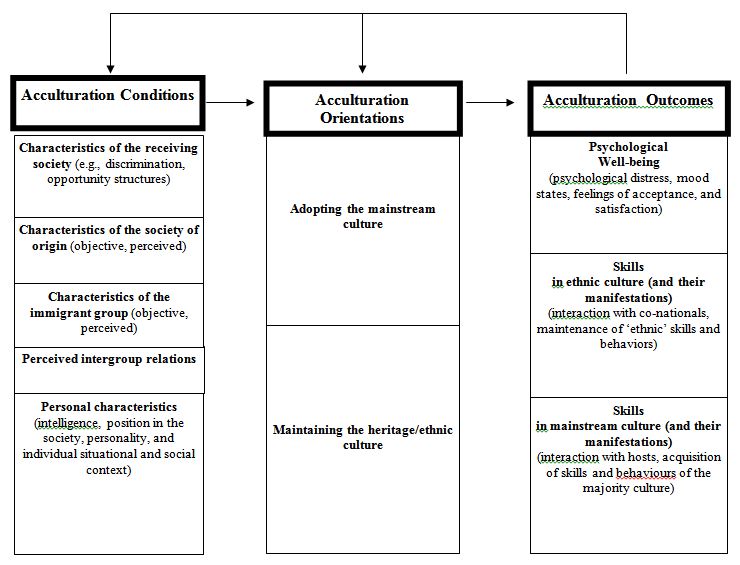Assessment of Immigration and Acculturation
Fons J. R. van de Vijver, PhD
Tilburg University, the Netherlands and North-West University, South Africa
Introduction
Immigration has affected and will continue to affect all societies. Acculturation refers to changes that an individual experiences as a result of contact with one or more other cultures and of the participation in the ensuing process of change that one's cultural or ethnic group is undergoing. From a psychological perspective, children may belong to their culture of origin, to the culture of the country of settlement, or to a combination. The basic argument of this article is that factoring adequate assessment into the acculturation process will improve its validity and quality.
Subject
Insight in the acculturative status of a person can provide valuable information in itself and it can help to interpret results of regular assessment procedures. For (recent) immigrants who often lack a good knowledge of the dominant society language, the use of standard assessment procedures is problematic.
Problems
A conceptual framework for studying acculturation that can guide assessment is given in Figure 1. Acculturation has three components: conditions, orientations (also called strategies), and outcomes. Acculturation conditions refer to (semi-)permanent factors in the environment as well as personal factors that have a bearing on how immigrants deal with the heritage and mainstream culture. Examples are cultural distance (i.e., distance between country of origin and settlement as evaluated by social indicators like national affluence levels or by self-reports in scales about experienced differences), intergroup relations, and personality traits. Acculturation orientations involve attitudes toward the culture of origin and the culture of the dominant society. Acculturation outcomes are usually split into psychological and sociocultural outcomes.1 The latter refer to “doing well” in the new culture (e.g., speaking the dominant language, school grades, and friendships with host national children), whereas the former refer to “feeling well” (e.g., depression and happiness).
A recurring issue in the assessment of acculturation is the focus on knowledge of the dominant language, either as self-reported skill level or as vocabulary knowledge and reading comprehension. The main problems with this approach are that language is just one aspect of acculturation, that language knowledge depends on time and schooling in the host culture, that language is often assessed with very few items (which makes it difficult to establish the reliability of the measure), and that a good knowledge of the language does not imply an exclusive orientation to the host culture.
Research Context
Views on acculturation orientations have largely moved from unidimensional to bidimensional models. Unidimensional models view acculturation as adjustment to the mainstream culture, with the simultaneous loss of the original culture.2 It has become increasingly clear that complete absorption in the mainstream culture and loss of the original culture are not inevitable endpoints of immigration. Bidimensional models are usually based on two underlying dimensions: Does the immigrant want to maintain the heritage culture and does the immigrant want to establish contacts with or want to adopt the culture of the country of destination?3
Key Research Questions
Much work in acculturation assessment has focused on orientations.4,5 Important research questions involve the design and validation of instruments to assess and their link with other psychological variables, ranging from school grades to clinical assessment.
Recent Research Results
Recent research has led to a number of insights about how to design instruments to measure acculturation orientations. It is important to cover both “public” and “private” domains in assessment procedures.6 Public domains involve life areas where immigrants have contacts with the dominant groups, such as education. Private domains refer to the life within the family and personal spheres of life, such as language use with parents and socialization patterns. Many immigrant groups show more cultural maintenance in the private domain and more adjustment in the public domain. Published acculturation scales often contain items that deal with both attitudes and behaviours. If a split is made between these types, items dealing with attitudes are usually part of orientation questionnaires and behavioural items are more commonly found in outcome measures.
Common methods to assess acculturation orientations, using self-reports, are listed in Figure 2. The most common item formats to assess self-reports of acculturation are the one-statement method, two-statement method, four-statement method, and vignettes. The choice of a bidimensional acculturation model makes a one-statement method less attractive, given that this method treats preferences for the two cultures as incompatible. The four-statement method has been criticized on psychometric and substantive grounds: all questions are by definition double barreled.7,8 For example, the item “I like to have American friends but I do not like to have Mexican friends” asks two questions at once. Children may have problems to express their endorsement when they agree with one part of the item and disagree with the other. Moreover, many acculturation items contain negations, which may be cognitively complex for some immigrants, especially children. Vignettes can also be challenging and contain specifics that trigger unwanted responses. There is evidence that the “two-statement method” is slightly better than other question formats to assess acculturation using self-reports.
“Hard” measures of acculturation involve generation status (e.g., first or second generation), country of schooling (in the country of origin or settlement), and language use. Psychological scales that measure acculturation orientations are examples of “soft” measures. Both types of measures have advantages and disadvantages. Strengths of “hard” measures are their brevity, ease in administration, high reliability, and the clarity of causal status (e.g., generation status cannot be an outcome variable). Weaknesses are their limited variation at individual level and their sometimes elusive links with acculturation-related psychological processes. These variables are often better seen as proxies that have a bearing on the acculturation that still needs “unpackaging.” “Soft” measures have converse pros and cons. More work is needed to integrate the two types of measures.
Research Gaps
The literature is replete with studies of ethnic groups in a single country. Comparative studies of acculturation are needed. Good examples are longitudinal studies, studies comparing a single ethnic group in different countries (e.g., Turkish immigrants in Canada and the United States), and studies comparing different groups in a single country (Turkish and Chinese immigrants in the United States). Comparative studies provide more scope for evaluating the role of antecedent conditions, such as ethnic vitality, which typically show little or no variation in current acculturation studies.
Conclusions
Acculturation assessment should become a standard part of procedures to evaluate immigrants. Acculturation test scores, in particular scores on sociocultural adjustment, can be important moderators of performance in other domains. There is no easy rule of thumb to establish when assessment of acculturation is no longer needed and the immigrant can be viewed as adjusted to the mainstream culture.
Implications for Parents, Services and Policy
Immigrants are in psychological flux, and changes are small for some and large for others. It is important for caregivers and professionals to appreciate the nature and dynamics of the acculturation process. Aspects such as duration of the stay, heritage and host language, distance between cultures, and preferences as to how to deal with both cultures, should be factored into service delivery. We need to move from “colorblind” applications of routine assessment procedures to culture-informed assessments. Much assessment, notably in education, is based on a deficiency view on cross-cultural differences. Focusing on knowledge of the dominant language and culture seems inevitably to define children from an immigrant background as deficient. This perspective may be useful for designing educational counseling, although it neglects attitudes toward and knowledge of native language and culture. By including information about acculturation in psychological assessment procedures we can do more justice to the cultural heterogeneity of immigrants and improve the validity of assessment and counseling.
Figure 1. Acculturation framework6

Figure 2. Common methods to assess acculturation orientations

References
- Ward C, Bochner S, Furnham A. The psychology of culture shock. London, UK: Routledge; 2001.
- Gordon MM. Assimilation in American life. New York, NY: Oxford University Press; 1964.
- Berry, JW. Immigration, acculturation, and adaptation. Applied Psychology: An International Review 1997;46:65-68.
- Rudmin FW. Acculturation, acculturative change, and assimilation: A research bibliography with URL links. In: Lonner WJ, Dinnel DL, Haye SA, Sattler DN, eds. Online readings in psychology and culture. Unit 8. Chapter 9. Available at http://www.wwu.edu/culture/readings.htm. Accessed April 12, 2011.
- Varas T. Instruments for measuring acculturation. 2009. Available at http://vtaras.com/Acculturation_Survey_Catalogue.pdf. Accessed April 12, 2011.
- Arends-Tóth JV, van de Vijver FJR. Issues in conceptualization and assessment of acculturation. In: Bornstein MH, Cote LR, eds. Acculturation and parent-child relationships: Measurement and development. Mahwah, NJ: Erlbaum; 2006: 33-62.
- Rudmin FW, Ahmadzadeh V. Psychometric critique of acculturation psychology: The case of Iranian migrants in Norway. Scandinavian Journal of Psychology 2001;42:41-56.
- Arends-Tóth JV, van de Vijver FJR. Assessment of psychological acculturation: Choices in designing an instrument. In: Sam DL, Berry JW, eds. The Cambridge handbook of acculturation psychology. Cambridge, UK; 2006: 142-160.
How to cite this article:
van de Vijver FJR. Assessment of Immigration and Acculturation. In: Tremblay RE, Boivin M, Peters RDeV, eds. Bornstein MH, topic ed. Encyclopedia on Early Childhood Development [online]. https://www.child-encyclopedia.com/immigration/according-experts/assessment-immigration-and-acculturation. Published: April 2011. Accessed April 23, 2024.
Text copied to the clipboard ✓